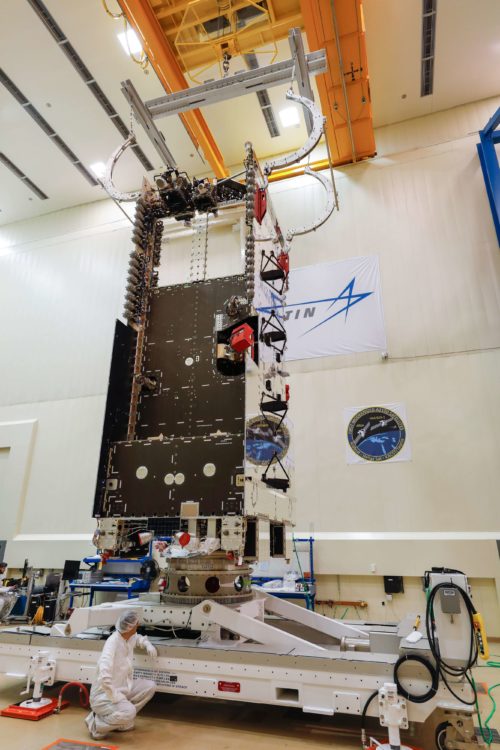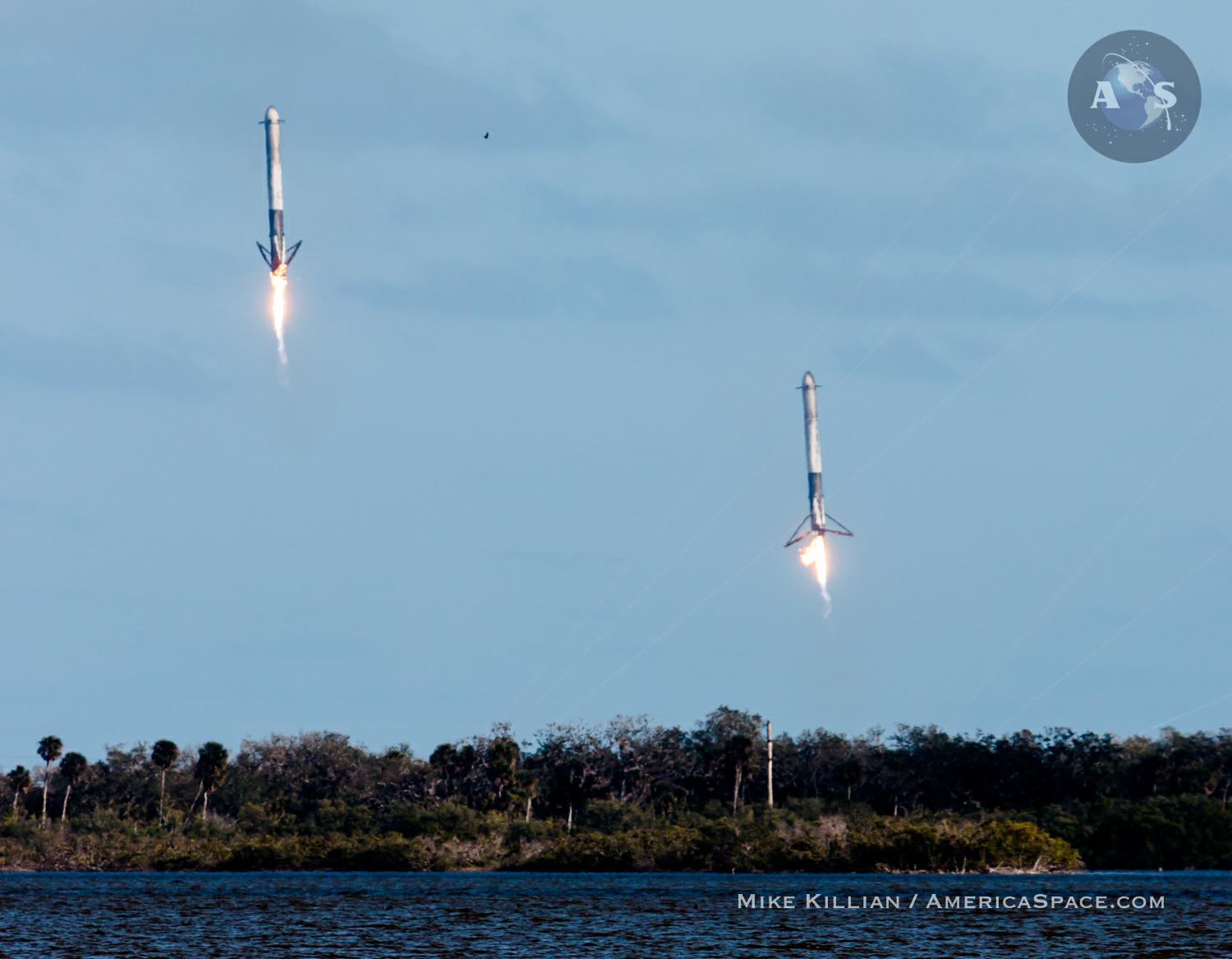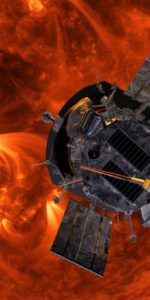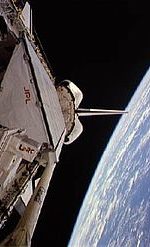
Fourteen months since its triumphant maiden voyage, the 27 engines of SpaceX’s mighty Falcon Heavy came to life again today (April 5) for a standard launch practice countdown (dress rehearsal) and Static Test Fire, which now paves way for the beast to soar again as soon as April 9, as it takes flight with its first commercial client.
Liftoff is scheduled to occur from historic Pad 39A at Florida’s Kennedy Space Center (KSC) during a two-hour “window”, which extends from 6:36 p.m. through 8:33 p.m. EDT, carrying the giant Arabsat 6A communications satellite and deploying it into geostationary orbit at 30.5 degrees East longitude to provide television, internet, telephone and secure communications services to customers throughout the Middle East, Africa and parts of Europe.
.
FOLLOW OUR LAUNCH TRACKER FOR UPDATES AND LIVE COVERAGE ON LAUNCH DAY!
.
Contracts to build Arabsat 6A were signed back in April 2015, between prime contractor Lockheed Martin and Riyadh-headquartered Arabsat and King Abdulaziz City for Science and Technology (KACST). Under the terms of the contract, two satellites—Arabsat 6A and HellasSat-4/SaudiGeoSat-1 (HS4/SGS1)—would be fabricated atop a modernized variant of Lockheed Martin’s tried-and-true A2100 spacecraft bus. Additionally, the contract initiated a joint venture to explore the design, manufacturing, assembly and integration of future satellites within the Kingdom of Saudi Arabia itself.
“This is a great step forward to support both Arabsat and the Kingdom’s long-term strategy to provide consumers and commercial customers with robust communications resources,” said Mike Hamel, then-vice president and general manager of commercial space at Lockheed Martin. “The modernized A2100 satellite platform is ideally suited to their mission of connecting people and societies through reliable telecommunications services.”
Both satellites were built at Lockheed Martin’s Denver, Colo., facility, and represent the most advanced commercial satellites ever built by the firm. In addition to an 18-year-plus “fuel-life”, the modernized A2100 boasts a hybrid electrical/liquid propulsion system—with Hall current thrusters and liquid apogee engine—to enable greater efficiency, as well as upgraded flight software and two lithium-ion batteries. Its flexible solar arrays are 30 percent lighter and 50 percent more powerful than earlier incarnations, providing in excess of 20 kilowatts and supporting a 16-kilowatt payload. Arabsat 6A is laden with eight communications system antennas, supporting 23 fixed Ka-band spot beams and a steerable Ka-band spot beam.

In September 2015, Lockheed Martin announced that HS4/SGS1 would benefit from highly agile payload technology, affording them flexible bandwidth and frequency management for secure communications, including the ability to dynamically reprogram on-orbit assets and make rapid adjustments to communications networks. “Our goal is to build a smarter satellite that routes capacity where you need it, when you need it,” explained Carl Marchetto, current vice president and general manager of commercial space at Lockheed Martin. “And with this technology now available on the modernized A2100 family, it will truly meet customer demand for increased flexibility.” It is expected that satellites outfitted with this flexible technology will be able to maximize revenue generation by dynamically shifting bandwidth to peak-demand areas.
Although HS4/SGS1 is equipped with this advanced beam-forming/hopping technology, Lockheed Martin’s Chris Pettigrew advised AmericaSpace that it is not aboard Arabsat 6A. All told, the firm currently has five orders for modernized A2100s on its books, with JCSat-17—currently undergoing final integration, ahead of an Ariane 5 launch later in 2019—and the next members of the Space-Based Infrared System (SBIRS 5 and 6) also based on this satellite architecture.
By May 2016, satellite and subsystem development for both Arabsat 6A and HS4/SGS1 passed smoothly through Critical Design Review (CDR), ensuring that designs were fully in-step with technical specifications, and the program was green-lighted to enter its build, integration and testing phase. By this point, according to Mr. Marchetto, Lockheed Martin had already begun to fabricate the satellites’ antenna reflectors, solar array panels and core structure. Final integration of HS4/SGS1 was completed in August 2017 and the satellite was delivered to Lockheed Martin’s facility in Sunnyvale, Calif., three months later. Meanwhile, in February 2018, Arabsat 6A assembly ended and it too was transported to Sunnyvale for testing. This punishing regime subjected both satellites to blasts of extreme sound, heat and cold and near-total vacuum, to evaluate their performance under the kind of stresses they will experience during launch, ascent and whilst on-orbit.

Two months ago, a European Ariane 5 booster successfully launched HS4/SGS1, where it is currently wrapping up its on-orbit testing phase, ahead of integration into the operational Arabsat network. In the meantime, Arabsat 6A was transported by road from Sunnyvale to Cape Canaveral in January 2019 to begin final processing for launch.
It has been a long 14 months since the world last heard the roar of over 5 million pounds of thrust from the 27 Merlin 1D+ engines of the Falcon Heavy’s core and side-mounted boosters, and this time, the triple-barreled machine is sporting all shiny brand new Block 5 cores. And SpaceX hopes to refly the side boosters on the next Falcon Heavy too, which is currently scheduled to launch this summer with the U.S. Air Force STP-2 mission.
Assuming they land of course next week. Earlier this week, the East Coast-based Autonomous Spaceport Drone Ship (ASDS)—nicknamed “Of Course I Still Love You”—was drawn out to sea, reportedly some 600 miles (967 km) downrange of the launch site, to await the oceanic recovery of the core stage. The twin side boosters, meanwhile, are planned to perform Return to Launch Site (RTLS) touchdowns on Landing Zones (LZ) 1 and 2, same as last February’s Falcon Heavy debut.

With test fire now complete, the rocket will be lowered to horizontal and rolled back into its nearby processing hangar to receive its payload, before rolling out again next week for its first launch attempt.
If you plan on visiting the Cape to witness the launch, be aware of new rules and road closures that will be in place ahead of the 100,000+ people expected to descend on the area to see the launch; do your homework (we will publish a story on this very soon anyway, so stay tuned).
As the Falcon Heavy readies for its second mission, attention was drawn earlier this week to the usefulness of the giant rocket—paired, intriguingly, with a Boeing-built Interim Cryogenic Propulsion Stage (ICPS)—to achieve NASA’s new goal of achieving boots on the Moon by 2024. At a town hall meeting of agency employees at NASA Headquarters on 1 April, NASA Administrator Jim Bridenstine identified the Falcon Heavy and an ICPS as one potentially realistic option of delivering an Orion spacecraft and European Service Module (ESM) to lunar orbit. In his remarks, Mr. Bridenstine stressed a number of difficulties associated with elevating the heavyweight stack from horizontal to vertical, via the Transporter-Erector (TE), as well as the need for pad modifications to handle vertical hypergolic loading.
“If we’re gonna land boots on the Moon in 2024, we have time and we have the ability to accept some risk and make some modifications,” he said. “All of that is on the table. There is nothing sacred here that is off the table. And that is a potential capability that could help us land boots on the Moon in 2024.” That said, Mr. Bridenstine was quick to point out that nothing—not the Falcon Heavy or the Delta IV Heavy—comes close to beating the capability of the in-development Space Launch System (SLS), which he pointed out offers the United States “the best option to get us to lunar orbit as soon as possible.”
.
.
FOLLOW AmericaSpace on Facebook and Twitter!
.
.






3 Comments
3 Pings & Trackbacks
Pingback:Where to Watch Wednesday’s Falcon Heavy Launch Locally « AmericaSpace
Pingback:Falcon Heavy Goes Operational; Delivers Arabsat 6A, Successfully Lands All Three Boosters « AmericaSpace
Pingback:Falcon Heavy Goes Operational; Delivers Arabsat 6A, Successfully Lands All Three Boosters